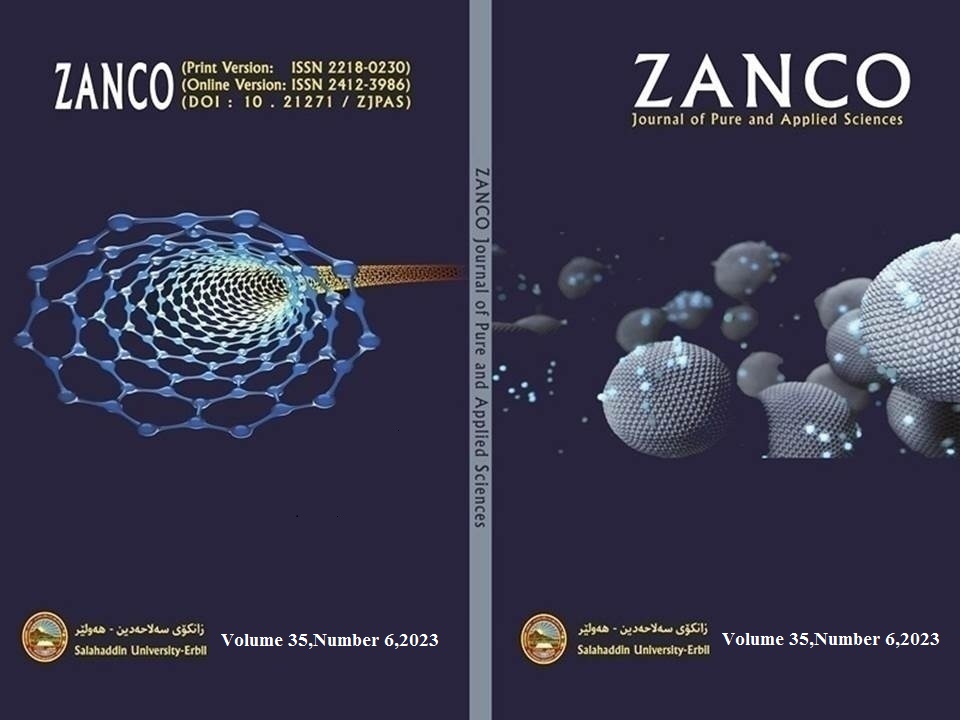The adoption of the Internet of Things in E-government towards the Smart Government
DOI:
https://doi.org/10.21271/ZJPAS.35.6.7Keywords:
Smart government, IOT, e-government, smart ServiceAbstract
The Internet of things (IoT) has given exceptional changes to all contexts in our lives, as the data can be collected and informed by smart devices in a real-time. E-government appears to be one of the many IoT application settings that can greatly benefit from the use of IoT, reforming and enhancing public services. The adoption of IoT in e-government encompasses a number of risks and challenges, including technological and non-technological issues that have to be resolved in order to create effective services and applications. This paper aims to propose a framework for smart government (SG) based on IoT usage. Also, it offers an inclusive overview of the key challenges and opportunities accompanying these new communications technologies in various disciplines. The findings indicate that IoT has a wide range of potential advantages, which suggests that IoT facilitates efficient knowledge management, sharing, and collaboration across domains at all levels of the organization.
References
Al-adawi, Z., Yousafzai, S., and Pallister, J. (2005). Conceptual Model of Citizen Adoption of E-government. Proceedings of the Second International Conference on Innovations in Information Technology, Dubai, UAE.
Al-Enezi, A., Al-Meraj, Z., and Manuel, P., (2018) Challenges of IoT based Smart-government Development, IEEE Green Technologies Conference (GreenTech), 2018, pp. 155-160.
Al-Obaithani, S. F. Ameen, A, and Alrajawy, A., (2018) Proposing Smart-Government Model: Theoretical Framework, International Journal of Management and Human Science (Ijmhs), Vol. 2 No. 2 (2018).
Abdelghaffar, H. and Magdy, Y. (2012). The Adoption of Mobile Government Services in Developing Countries: The Case of Egypt. International Journal of Information and Communication Technology Research, 2(4), pp. 333-341
Almaiah, M.A.; Nasereddin, Y. (2020) Factors influencing the adoption of e-government services among Jordanian citizens. Electron. Gov. Int. J. 2020, 16, 236–259.
Almuraqab, A. S. N., (2017) Smart Government Services Adoption In The Uae: A Conceptual Model, Proceedings of Researchfora International Conference, At: Abu Dhabi
Althunibat, A., Binsawad, M., Almaiah, M.A., Almomani, O., Alsaaidah, A., Al-Rahmi, W. and Seliaman, M.E., (2021) Sustainable applications of smart-government services: A model to understand smart-government adoption. Sustainability, 13(6), p.3028.
Ameen A. Salmeen, F. and Nusari, M., (2018) Proposing SMART-Government Model: Theoretical Framework, nternational Journal of Management and Human Science (IJMHS), Volume 2, Issue 2, Pages 27-38, 2018eISSN: 2590-3748
Anas, R., Al-Soud, H., Al-Yaseen, S. and Al-Jaghoub, H. (2014). Jordan’s e- overnment at the crossroads. Transforming Government: People, Process and Policy, 8(4), pp. 597 – 619
Anthopoulos, G. L., (2015) Understanding the Smart City Domain: A Literature Review. In: Rodríguez-Bolívar M. (eds) Transforming City Governments for Successful Smart Cities. Public Administration and Information Technology, vol 8. 2015.
Anthopoulos, L. G., (2017) Understanding Smart Cities: A Tool for Smart Government or an Industrial Trick? Greece: Springer, 2017
Anthopoulos, L. Sirakoulis, K. Reddick, C., (2021) Conceptualizing Smart Government: Interrelations and Reciprocities with Smart City. Digital Government: Research and PracticeVolume 2, Issue 4, October 2021.
Arendsen, R. Ter Hedde, M. J., and Hermsen, H., (2011) Electronic Government, vol. 6846. 2011.
Arief, A. and Sensuse, I. D., (2018) Designing A Conceptual Model for Smart Government in Indonesia using Delphi 2nd Round Validity, International Conference on Advanced Computer Science and Information Systems (ICACSIS), 2018, pp. 93-98, doi: 10.1109/ICACSIS.2018.8618239.
Balte, A., Kashid, A., & Patil, B. (2015). Security issues in internet of things (IoT): A survey. International Journal of Advanced Research in Computer Science and Software Engineering, 5(4), 450-455.
Brous, P., and Janssen, M., (2016) Advancing e-Government Using the Internet of Things: A Systematic Review of Benefits, EGOV.
Carter, L., and Bélanger, F., (2005) “The utilization of e-government services: Citizen trust, innovation and acceptance factors,” Inf. Syst. J., vol. 15, no. 1, pp. 5–25, 2005.
Chatfield, T. A. Reddick, G. C., (2019) A framework for Internet of Things-enabled smart government: A case of IoT cybersecurity policies and use cases in U.S. federal government, Government Information Quarterly, Volume 36, Issue 2, April 2019, Pages 346-357
Chatterjee, S., Kar, A. K., & Gupta, M. P. (2018). Success of IoT in smart cities of India: An empirical analysis. Government Information Quarterly, 35(3), 349–361. https://doi.org/10.1016/j.giq. 2018.05.002
Cho, S., Oh, S., Rou, H., Gim, G. (2021) Study on Security and Privacy of E-Government Service. In: Kim, J., Lee, R. (eds) Data Science and Digital Transformation in the Fourth Industrial Revolution. Studies in Computational Intelligence, vol 929. Springer, Cham.
Chumakova, O. (2017) “Features of “Smart City” Concept in Urban Paradigm of Globalization”, in MATEC Web Conf 2017;106:01030. doi:10.1051/matecconf/201710601030.
Conradie, P., & Choenni, S. (2014). On the barriers for local government releasing open data. Government Information Quarterly, 31, S10-S17.
Cooke, A. (2018) Realising the future and full potential of connected IoT devices with AI. Silicon Republic, Available at https://www.siliconrepublic.com/enterprise/ai-iot-automation-ibm. Accessed: 18/09/2022.
Dahi, M. and Ezziane, Z. (2015). Measuring e-government adoption in Abu Dhabi with technology acceptance model (TAM), International Journal of Electronic Governance, 7(3), pp. 206-231
Eremia, M., L. Toma, and M. Sanduleac. (2017) “The Smart City Concept in the 21st Century.” Procedia Engineering 2017 181: 12–9. doi:10.1016/j.proeng.2017.02.357.
Fernandez, V., Velazquez, G., and Prada, P., (2015) Governance and Implementation of Smart City Projects in the Mediterranean Region, European Investment Bank Institute, Deliverable 3, 2015
Giełda, M., (2019) Dimensions of Smart Administration. Wroclaw Review of Law, Administration & Economics, Vol 9, issue 2. Available: http://repozytorium.uni.wroc.pl/Content/128800/PDF/4_Gielda_M_Dimensions_of_Smart_Administration.pdf. Accessed: 23/10.2022.
Gilbert, D., Balestrini, P., & Littleboy, D. (2004). Barriers and benefits in the adoption of e-government. International Journal of Public Sector Management, 17(4), 286-301.
Gil-Garcia, J. R., Helbig, N., and Ojo, A. (2014). Being smart: Emerging technologies and innovation in the public sector. Government Information Quarterly, 31, I1-I8.
Gil-Garcia, J. R. Zhang, J. and Puron-Cid, G. , (2016) Conceptualizing smartness in government: An integrative and multi-dimensional view,” Gov. Inf. Q., vol. 33, no. 3, pp. 524–534, 2016.
Guangwei Hu, Sohail Raza Chohan & Jianxia Liu (2022) Does IoT service orchestration in public services enrich the citizens’ perceived value of digital society?, Asian Journal of Technology Innovation, 30:1, 217-243, DOI: 10.1080/19761597.2020.1865824
Hans, H., Stuart, J., Tina, R. and Marcus, M. (2005). Driving Consumer Acceptance Of Mobile Marketing: A theoretical framework and empirical study. Journal of Electronic Commerce Research, 6(3), pp. 181-192
Harsh, A., Ichalkaranje, N. (2015). Transforming e-Government to Smart Government: A South Australian Perspective. In: Jain, L., Patnaik, S., Ichalkaranje, N. (eds) Intelligent Computing, Communication and Devices. Advances in Intelligent Systems and Computing, vol 308. Springer, New Delhi.
Herdiyanti, A. SekarHapsari, P. and DwiSusanto, T., (2019) Modelling the Smart Governance Performance to Support Smart City Program in Indonesia, Procedia Computer Science, Volume 161, 2019, Pages 367-377.
Jain, R., (2016) Internet of Things and Smart Cities: Challenges and Issues, 2nd IEEE International Workshop on Sensors and Smart Cities (SSC2016), St. Louis, MO, May 18, 2016.
Janssen, M., Charalabidis, Y., & Zuiderwijk, A. (2012). Benefits, Adoption Barriers and Myths of Open Data and Open Government. Information Systems Management,, 29(4), 258-268
Jiménez, C. E., Falcone, F., Solanas, A., Puyosa, H., Zoughbi, S., & González, F. (2014). Smart Government: Opportunities and Challenges in.Handbook of Research on Democratic Strategies and Citizen-Centered E-Government Services, 1.
Jovanovic, B., (2022) Internet of Things statistics for 2022 - Taking Things Apart. [online] available at: https://dataprot.net/statistics/iot-statistics/, Accessed: 24/10/2022
Kim, J. H., Yoo, M., Lee, K. N., & Seo, H. (2017) The innovation of the internet: A semantic network analysis of the internet of things. Asian Journal of Technology Innovation, 25(1), 129–139. https://doi.org/10.1080/19761597.2017.1302549
Kitchin, R. (2016) Getting smarter about smart cities: Improving data privacy and data security. Data Protection Unit, Department of the Taoiseach, Dublin, Ireland.
Kliksberg, B. (2000). Rebuilding the state for social development: towards ‘smart government’. International Review of Administrative Sciences, 66, 241-257.
Kopetz, H., (2011) Internet of things. Real-Time Systems, pp. 307–323. Springer (2011)
Lee M., and Turban E. (2001). A Trust Model for Consumer Internet Shopping. International Journal Electronic Commerce. 6, pp. 75-91
Li, Y., Lin, Y., and Geertman, S.C. (2015). The development of smart cities in China.
McKnight, D., Choudhury, V., Kacmar, C. (2002). The Impact of Initial Consumer Trust on Intentions to Transact with a Web Site: A Trust Building Model. J. Strategic Information System. 11, pp. 297-323.
Mellouli, S., Luna-Reyes, L. F., & Zhang, J. (2014). Smart government, citizen participation and open data. Information Polity, 19(1, 2), 1-4.
Mitchell, S., Villa, N., Stewart, M., Lange, A., (2013) The Internet of Everything for Cities, Point of View, CISCO, 2013
Mofleh, S., and Wanous, M. (2008). Understanding Factors Influencing Citizens’ Adoption of e-Government Services in the Developing World: Jordan as a Case Study. Journal of Computer Science, 7(2), pp.1-11
Omar, E. Khalil, and Al-Nasrallah A. (2014). The Adoption of the Traffic Violation E-payment System (TVEPS) of Kuwait. Electronic Journal of Knowledge Management,12(1), pp. 3 - 22.
Ovais, A., Markkula, J., Oivo, M. (2013). Factors affecting egovernment adoption in Pakistan: a citizen's perspective. Transforming Government: People, Process and Policy, 7(2), pp. 225-239
Papadopoulou, P. Kolomvatsos, K. and Hadjiefthymiades, S., (2019) Enhancing E Government With Internet of Things, In book: Advances in Computational Intelligence and Robotics, IGI Global’s, DOI: 10.4018/978-1-5225-7955-7.ch005.
Petrov, O. (2011) Next generation e-government: transformation into open government, ICT@The World Bank, E-Democracy Conference, Ohrid, Macedonia
Petrov, O., (2014) Open Data as a Key Enabler of Smart Government,17th National Conference on e-Governance Kochi, India, January 30, 2014.
Ramos, C., Augusto, J.C., Shapiro, D., (2008) Ambient Intelligence-the Next Step for Artificial Intelligence. IEEE Intell. Syst. 23, 15–18.
Rehman, M., Esichaikul, V. and Kamal, M. (2012). Factors influencing e-government Adoption in Pakistan. Transforming Government: People, Process and Policy, 6(3) pp. 258–282
Riccardo, P., Valeria, L., and Nathalie, M., (2015) Towards a smart city based on cloud of things, a survey on the smart city vision and paradigms. Transactions on emerging telecommunications technologies, Wiley-Blackwell, 2015, pp.1–11. ff10.1002/ett.2931ff. ffhal-01116370f
Santa, R. Macdonald, B. J. and Ferrer, M., (2019) The role of trust in e-Government effectiveness, operational effectiveness and user satisfaction: Lessons from Saudi Arabia in e-G2B, Government Information Quarterly, Volume 36, Issue 1, January 2019, Pages 39-50
Scholl, H. J., & Scholl, M. C. (2014) Smart governance: A roadmap for research and practice. iConference 2014 Proceedings.
Schedler, K. Guenduez, A. A., and Frischknecht, R., (2019) How smart can government be?Exploring barriers to the adoption of smart government, Information Polity, volume 24, Issue 2.
Seang-Tae Kim (2013) Next Generation e-Government Strategies and Asks for the Smart Society --Based on Korea's Case, Journal of E-Governance, Pages 12-24, Volume 36 Issue 1.
Shareef, M. S., Jahankhani, H. Dastbaz, M., (2012) E-government stage model: Based on citizen-centric approach in regional government in developing countries. International Journal of Electronic Commerce Studies 3 (1), 145-164
Sudan, R. (2000). Towards SMART government: the Andhra Pradesh experience. Indian Journal of Public Administration, 46(3), 401-410
Von Lucke, J., (2016) Smart government – the potential of intelligent networking in government and public administration. In: Proceedings of CeDEM 2016 – Conference for e-Democracy and Open Government (CeDEM), pp. 137–144, Available at: (2016) https://doi.org/10.1109/cedem.2016.22, accessed: 36/09/2022.
Wu, J., and Wang, S. (2005). What Drives Mobile Commerce?: An Empirical Evaluation of the Revised Technology Acceptance Model. Information & Management, 42(5), pp. 719-729.
Zynoddini, R. M., Taghva, R. M., Fard, T. M., Moeini, A., Hesari, R. M., and Armaki, A. A., (2018) The Smart Government Maturity Model. Available at: The Smart Government Maturity Model.pdf. Accessed: 10/09/2022.
Downloads
Published
How to Cite
Issue
Section
License
Copyright (c) 2023 Shareef M. Shareef

This work is licensed under a Creative Commons Attribution 4.0 International License.














